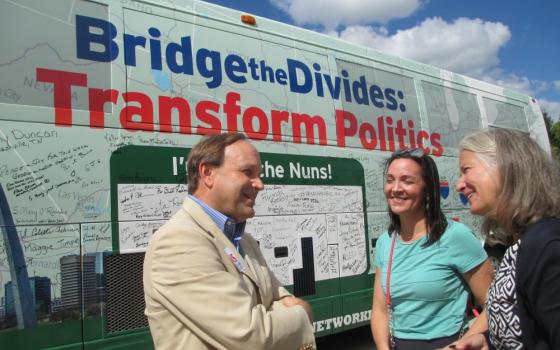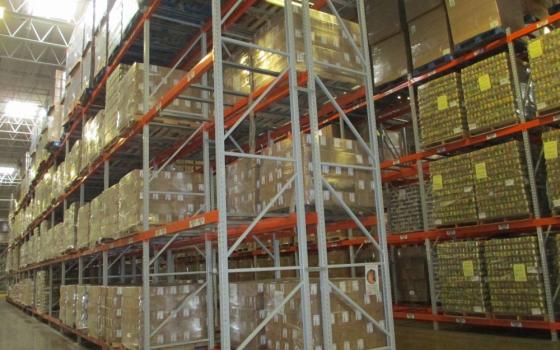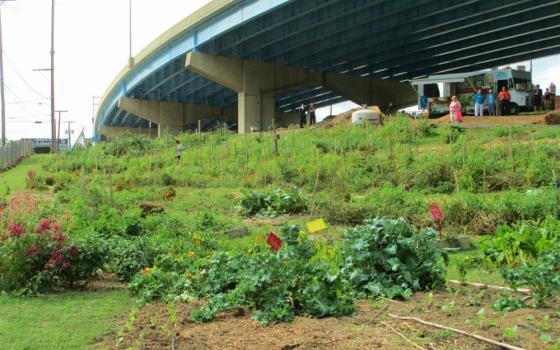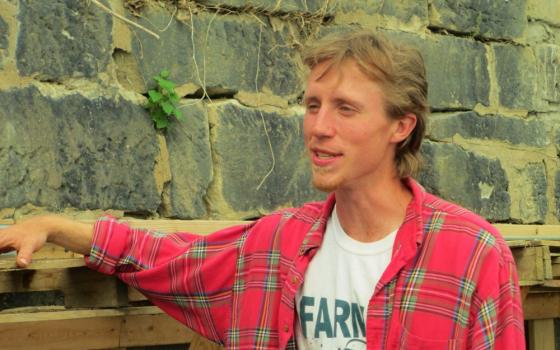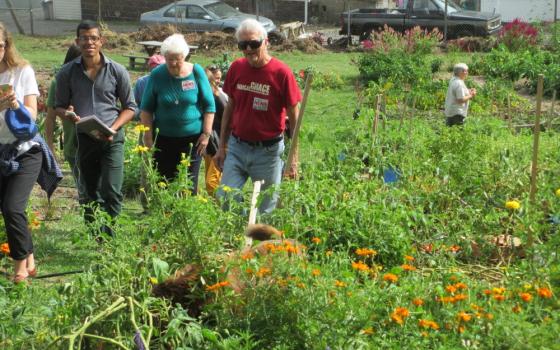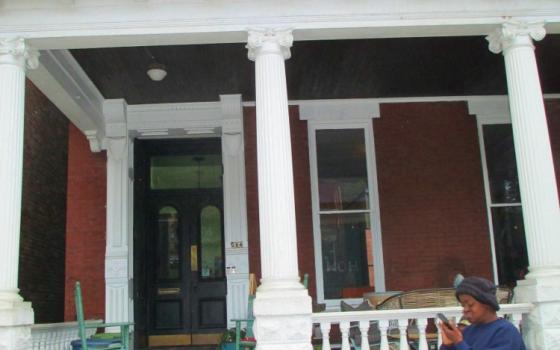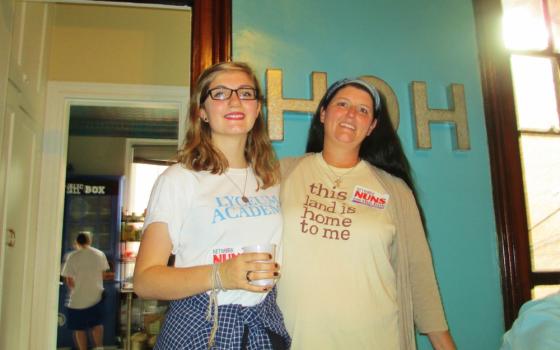We are on the Bus on our way to Washington, having made our last stop in Wheeling, West Virginia. During the silent time of our prayer this morning, the faces of people we have met along the way kept rolling through my mind. Next this scripture passage was read: “Look! I am making something new. Now it springs forth, do you not perceive it?” (Is. 43:19-21) How appropriate!
We have been so blessed by all the creative people we have encountered along the way. Their self-giving is watering deserts, blossoms are bursting forth.
On Day 11 of Nuns on the Bus, in Grove City, near Columbus, Ohio, we met Matt Habash, President and CEO of Mid-Ohio Foodbank. He and Board Chair Jon Cardi of SafeliteAuto and Marilyn Tomasi, Facility Manager, walked us through the LEED Gold certified warehouse. They rehabbed an old mattress facility, increasing their storage capacity to 204,000 square feet and making Mid-Ohio the 10th largest foodbank in the nation.
But that isn’t the only revamping that’s happening. They are rethinking their strategy and recreating their entire mission, adding the phrase “to co-create a community where everyone thrives” to their vision statement of “a hunger-free and healthy community.” They see the interrelationships and strengthen the connections.
Following the release of research into the causes of chronic diseases such as diabetes and obesity, Mid-Ohio has revamped their entire distribution system over the last five years so that fresh fruits and vegetables comprise 60 percent of the food they make available. They are reaching out to health care professionals to partner with them in nutrition education, the ability to track the clients and to talk to physicians about writing prescriptions for fresh fruits and vegetables. They are engaging in other on-the-ground research to make sure what they are doing is meeting the needs. Mid-Ohio is also expanding their own gardens and have plans to start a “pay it forward” restaurant where anyone can pay what they can afford.
And because of their tracking systems they are de-bunking some myths about the people coming to food pantries: 80 percent of their clients come five times a year or less.
They have raised the salaries of their employees to $15 per hour and are encouraging other businesses in the area to do likewise by showing them how it pays off.
In speaking with Matt, it became clear that the key to developing new models is to stay focused on the clients, without making assumptions or judgments. All are invited into creating the community: private and public sector, volunteers, donors and those being served. And adjustments are made in their ways of operating to facilitate community-building.
The creative grace of the Spirit is swirling in, around and through Mid-Ohio Foodbank. “Look! I am making something new!
______
On Day 12, we pulled into Wheeling, West Virginia to visit Grow Ohio Valley, Farm 18, right in the midst of an area with high poverty rates. We met Danny Swan, a young man who had lived at Mother Jones House while a student at Wheeling Jesuit University. He wanted to remain connected with the children in the neighborhood, so upon graduation he built a teepee and lived there for 18 months. Wanting to find a way to make fresh fruits and vegetables available, Grow Ohio Valley received permission to start gardening on the ground cleared for construction of a highway. Danny started reclaiming the land.
They re-tooled a Snap On truck to make a mobile fresh food market to deliver the produce grown in the highway right of way six days a week to 20 stops in a 3 county area and to members of their CSA (Community Supported Agriculture).
Starting with the little they had, they utilized a 150 year-old stone wall to incorporate energy saving features into their greenhouse. More creative plans are in the works: they have acquired a five-acre plot next to a housing project and plan to plant 4,000 to 5,000 apple trees.
“Food is just the medium for forming community,” Danny explained. They strengthen relationships through all they do.
As we walked toward House of Hagar Catholic Worker we were greeted by a drummer and hula hoopers. Kate Marshall and her family acquired a house that dates back to at least 1862 and rehabbed it. Given the origin of West Virginia as a free state, Kate thought it appropriate to name the house after Hagar, the slave of Sarah, who brought to contemplation the question of God, “Where have you come from and where are you going?” and claiming her dignity named God “You are the One who sees me.” (Gen 16:7-16)
With people coming and going we sat down for a feast of food, beauty and laughter. Sitting there, I gave thanks that my journey with Nuns on the Bus had come full circle: from my background and relationship with Holy Family Catholic Worker House in Kansas City, Missouri, to the House of Hagar Catholic Worker on our last stop.
As we departed, we were blessed on our way with a reading from the “People’s Pastoral” of Appalachia, which will be published in Advent, reminding us that the poor and marginalized are our first teachers.
That echoed the impression I’ve gained through this Nuns on the Bus trip: new communities are being created with persons who are poor or marginalized and the Earth as teachers. We’ve witnessed it everywhere. We’ve heard it at our town hall gatherings. People are yearning for it.
I’m convinced this is the way forward.
Now we’re on to Washington, D.C. to greet Pope Francis and hear his message.
Deep within myself I hear “Look! I am creating something new.”
[Jan Cebula, OSF, is liaison to women religious in the United States for Global Sisters Report. She joined the Nuns on the Bus Sept. 16 and rode with them all the way to Washington, D.C. Sept. 22.]
